|
|
|
Sort Order |
|
|
|
Items / Page
|
|
|
|
|
|
|
| Srl | Item |
| 1 |
ID:
140084
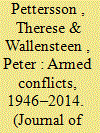

|
|
|
|
|
| Summary/Abstract |
In 2014, the Uppsala Conflict Data Program (UCDP) recorded 40 armed conflicts with a minimum of 25 battle-related deaths, up by six from 2013. This is the highest number of conflicts reported since 1999, and 11 of these conflicts were defined as wars, that is, conflicts generating 1,000 or more battle-related deaths in one calendar year. Further, an escalation of several conflicts, coupled with the extreme violence in Syria, resulted in the highest number of battle-related deaths in the post-1989 period. Yet, compared to the large-scale interstate wars of the 20th century, the number of fatalities caused by armed conflicts in 2014 was relatively low. Additionally, seven conflicts identified in 2013 were no longer active in 2014. However, four new conflicts erupted in 2014, all of them in Ukraine, and three previously registered conflicts were restarted by new actors. Furthermore, six conflicts reoccurred with previously registered actors. A positive development, however, is the increase to ten of the number of peace agreements concluded and signed in 2014, which represents a further four compared with 2013. And although this increase is part of a positive trend since 2011, it is worth noting that several peace processes remained fragile by the end of the year.
|
|
|
|
|
|
|
|
|
|
|
|
|
|
|
|
| 2 |
ID:
154842
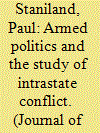

|
|
|
|
|
| Summary/Abstract |
Though the two are often conflated, violence is not identical to conflict. This article makes the case for studying state-armed group interactions across space, time, and levels of violence as part of an ‘armed politics’ approach to conflict. It conceptualizes and measures armed orders of alliance, limited cooperation, and military hostilities, and the termination of these orders in collapse or incorporation. The article applies this framework to four contexts in South Asia. It measures armed orders across five groups and six decades in Nagaland in India, and then offers a briefer overview of state-group armed orders in Karachi in Pakistan, Mizoram in India, and Wa areas of northern Burma/Myanmar. Examining armed politics improves our understanding of ceasefires and peace deals, rebel governance, and group emergence and collapse, among other important topics. This approach complements existing data on civil conflict while identifying a new empirical research agenda and policy implications.
|
|
|
|
|
|
|
|
|
|
|
|
|
|
|
|
| 3 |
ID:
172146
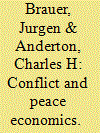

|
|
|
|
|
| Summary/Abstract |
In reviewing the sweep of the extant literature over the past century or so, we first define and present an overview and conceptual synthesis of the field of conflict economics with a special view toward the subfield of peace economics. We explain that standard textbook economics is a special case of conflict economics and discuss assumptions, subject matter, and interrelations between economics and conflict. We also briefly discuss the nature of the peace and security good, including transboundary and transgenerational aspects. Second, focusing on new research opportunities arising from behavioral, identity, and social network economics we identify entire branches of economic theory that have been little harvested as yet to help address important aspects of conflict and peace. We provide illustrative models, each tied to economics’ standard rational choice setup. Third, we reflect on the use of conflict-related datasets in empirical research, illustrated with examples pertaining to data validity, missing data, data merging, and data mining.
|
|
|
|
|
|
|
|
|
|
|
|
|
|
|
|
| 4 |
ID:
125139
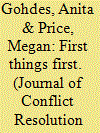

|
|
|
|
|
| Publication |
2013.
|
| Summary/Abstract |
We address weaknesses in the Peace Research Insitute Oslo (PRIO) Battle Deaths Dataset, and as a result draw contradicting conclusions to those presented by Lacina and Gleditsch. Our analysis focuses on the availability of data on battle deaths within specific conflict-years and problems encountered when data from multiple types of sources are combined. We repeat Lacina, Gleditsch, and Russett's analysis of battle deaths over time, with an attempt to provide a more robust model and incorporate an estimate of the uncertainty present in the PRIO Battle Deaths Dataset. This reanalysis reveals that the data used to establish the PRIO Battle Deaths Dataset does not offer a clear answer as to whether battle deaths have decreased or increased since the end of the Second World War. We contend that while the PRIO Battle Deaths Dataset offers the most comprehensive assembly of battle deaths data available to date, it is not suitable for analysis across countries or over time.
|
|
|
|
|
|
|
|
|
|
|
|
|
|
|
|
| 5 |
ID:
112415
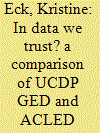

|
|
|
|
|
| Publication |
2012.
|
| Summary/Abstract |
In recent years, several large-scale data-collection projects have produced georeferenced, disaggregated events-level conflict data which can aid researchers in studying the microlevel dynamics of civil war. This article describes the differences between the two leading conflict events datasets, the Uppsala Conflict Data Program Georeferenced Events Dataset (UCDP GED) and the Armed Conflict Location Events Dataset (ACLED), including their relative strengths and weaknesses. The aim of the article is to provide readers with some guidelines as to when these datasets should be used and when they should be avoided; it finds that those interested in subnational analyses of conflict should be wary of ACLED's data because of uneven quality-control issues which can result in biased findings if left unchecked by the researcher. The article concludes that those interested in non-violent events such as troop movements have only ACLED to choose from, since UCDP has not coded such data, but again warns researchers to be wary of the quality of the data. Finally, while the creation of these datasets is a positive development, some caveats are raised in relation to both datasets about the reliance on media sources.
|
|
|
|
|
|
|
|
|
|
|
|
|
|
|
|
| 6 |
ID:
190999
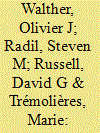

|
|
|
|
|
| Summary/Abstract |
While the location of violent events and their propensity to cluster together in space is increasingly well known, a deeper exploration of their spatiality and spatial evolution over time remains an emerging frontier in “Big Data”-driven conflict studies. The new Spatial Conflict Dynamics indicator (SCDi) introduced in this article contributes to fill this gap, by measuring both the intensity and spatial concentration of political violence at the subnational level. Articulating between point pattern and areal spatial analyses, the SCDi allows conflict researchers and analysts to not just map which regions experience the most violence but to track how the geography of conflict evolves over time. The SCDi identifies four spatial typologies of violence and can leverage political event data from most datasets with locational information and can be used for analyses across large multi-state regions, within a single state, or in more localized contexts. In this paper, we illustrate the SCDi with an application to the case of North and West Africa, analyzing over 30,000 discrete events through a twenty-two-year time span and across a twenty-two-state geographical area. We perform a longitudinal analysis of the SCDi typologies to show how the indicator can inform a theory of the spatial lifecycle of violence in the region. The indicator, therefore, has potential as both an analytic tool and a window on conflict episodes, showing how they can change from conflict initiation through resolution.
|
|
|
|
|
|
|
|
|
|
|
|
|
|
|
|
| 7 |
ID:
112781
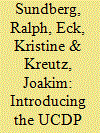

|
|
|
|
|
| Publication |
2012.
|
| Summary/Abstract |
This article extends the Uppsala Conflict Data Program (UCDP) by presenting new global data on non-state conflict, or armed conflict between two groups, neither of which is the state. The dataset includes conflicts between rebel groups and other organized militias, and thus serves as a complement to existing datasets on armed conflict which have either ignored this kind of violence or aggregated it into civil war. The dataset also includes cases of fighting between supporters of different political parties as well as cases of communal conflict, that is, conflict between two social groups, usually identified along ethnic or religious lines. This thus extends UCDP's conflict data collection to facilitate the study of topics like rebel fractionalization, paramilitary involvement in conflict violence, and communal or ethnic conflict. In the article, we present a background to the data collection and provide descriptive statistics for the period 1989-2008 and then illustrate how the data can be used with the case of Somalia. These data move beyond state-centric conceptions of collective violence to facilitate research into the causes and consequences of group violence which occurs without state participation.
|
|
|
|
|
|
|
|
|
|
|
|
|
|
|
|
| 8 |
ID:
180201
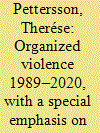

|
|
|
|
|
| Summary/Abstract |
This article reports on trends in organized violence, building on new data by the Uppsala Conflict Data Program (UCDP). The falling trend in fatalities stemming from organized violence in the world, observed for five consecutive years, broke upwards in 2020 and deaths in organized violence seem to have settled on a high plateau. UCDP registered more than 80,100 deaths in organized violence in 2020, compared to 76,300 in 2019. The decrease in violence in Afghanistan and Syria was countered by escalating conflicts in, for example, Artsakh (Nagorno-Karabakh), Azerbaijan and Tigray, Ethiopia. Moreover, the call for a global ceasefire following the outbreak of the COVID-19 pandemic failed to produce any results. In fact, the number of active state-based and non-state conflicts, as well as the number of actors carrying out one-sided violence against civilians, increased when compared to 2019. UCDP noted a record-high number of 56 state-based conflicts in 2020, including eight wars. Most of the conflicts occurred in Africa, as the region registered 30 state-based conflicts, including nine new or restarted ones.
|
|
|
|
|
|
|
|
|
|
|
|
|
|
|
|
| 9 |
ID:
186868
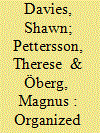

|
|
|
|
|
| Summary/Abstract |
This article reports on trends in organized violence, building on new data by the Uppsala Conflict Data Program (UCDP). The falling trend in fatalities stemming from organized violence in the world, observed between 2014 and 2019, was decisively reversed in 2021 as fatalities increased significantly. UCDP registered more than 119,100 deaths in organized violence in 2021, a 46% increase from the previous year. The increase was largely driven by escalating conflicts in Afghanistan, Ethiopia, and Yemen. Fatalities increased in all three categories of organized violence, despite a decrease in the number of active state-based conflicts, as well as the number of actors carrying out one-sided violence against civilians. UCDP recorded 54 state-based conflicts in 2021, a decrease by two compared to the previous year. Five of the conflicts were active at the intensity of war, the lowest number of wars since 2010. Violence in 2021 was thus concentrated to fewer but bloodier conflicts. Unmanned aerial vehicles (UAVs), commonly known as drones, have become increasingly important features of modern conflicts, and the trend in their usage is discussed in the special feature section. UAV usage has since 2019 dispersed among a significant larger number of actors, even as the downscaling in the involvement of the United States in the war on terror has led to a decrease in drone-related fatalities.
|
|
|
|
|
|
|
|
|
|
|
|
|
|
|
|
| 10 |
ID:
167284
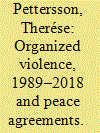

|
|
|
|
|
| Summary/Abstract |
This article reports on trends in organized violence and peace agreements collected by the Uppsala Conflict Data Program (UCDP). The number of fatalities in organized violence decreased for the fourth consecutive year, to reach the lowest level since 2012. In 2018, UCDP recorded almost 76,000 deaths: a decrease of 20% compared to 2017, and 43% compared to the latest peak in 2014. State-based armed conflict drives this downward trend in organized violence, with Syria accounting for much of the change. The number of civilians killed in one-sided violence also dropped in 2018, reaching its lowest level since 2012. In contrast, non-state conflict remained on a high level. The general decline in fatalities from organized violence does not correspond with the trend in the number of active conflicts. In fact, the world has seen a new peak in the number of conflicts after 2014, matched only by the number of conflicts in the early 1990s. In 1991, the peak in the number of armed conflicts corresponded with a similar peak in the number of signed peace agreements. This was followed by a decrease in the number of conflicts in the late 1990s and early 2000s. However, the most recent rise in armed conflicts has not been matched by a similar rise in the number of peace agreements. Two circumstances that characterize the recent rise in conflicts have also been found to make conflicts harder to solve: explicit religious claims and high levels of internationalization.
|
|
|
|
|
|
|
|
|
|
|
|
|
|
|
|
| 11 |
ID:
187394
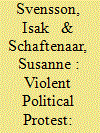

|
|
|
|
|
| Summary/Abstract |
This article presents the Uppsala Conflict Data Program (UCDP) “Violent Political Protest” (VPP) data set: a new –standalone- category of organized violence, which complements, and is compatible with, UCDP’s three categories of organized violence: one-sided violence, non-state, and state-based conflict. It consists of violent political protests, with at least 25 casualties during a year, in which informally organized civilians challenge states over governmental or territorial issues. We describe the data collection process, and demonstrate the data’s use with empirical analyses. Violent political protest is present globally, but most prevalent in the Middle East and Africa, and increasingly common over time. Violent political protest frequently co-occurs with state-based conflicts, but rarely due to conflict escalation. We explore if this is due to shared contexts, and find that gender inequality increases the likelihood of VPP onset, similar to state-based conflicts. Finally, we identify avenues for future research, including using VPP to assist in a more precise and complete analysis of organized violence.
|
|
|
|
|
|
|
|
|
|
|
|
|
|
|
|
| 12 |
ID:
125145
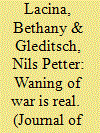

|
|
|
|
|
| Publication |
2013.
|
| Summary/Abstract |
A number of recent studies argue that there is decline in armed conflict within and between nations. Gohdes and Price run against the grain in arguing that there is no evidence for a decrease in battle deaths in armed conflicts after World War II and that the trend reported in our earlier articles is spurious. However, they do not plausibly justify this thesis. We reexamine the argument for a decline, exploring nonlinearities in the data and potential biases due to measurement error. We find that very strong assumptions must hold in order for measurement errors to explain the trend in battle deaths.
|
|
|
|
|
|
|
|
|
|
|
|
|
|
|
|
|
|
|
|
|